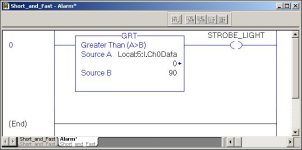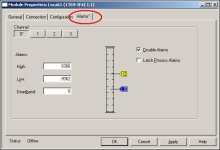first of all, you need to use valid tagnames ... (you can't have spaces, etc.) ... you could also just double-click on the XIC and use the Base tagname instead of an alias ... (example: Local:5:I.Ch0HAlarm) ...
then you need to nail down the scale for the input signals ... you're using "Engineering Units" which is probably going to come out as something like 4000 to 20000 ... somewhere along the line you'll probably want to convert that into a temperature reading ... what type of RTD are you using - and what range of values will you have for the input channel? ... in other words, 4 mA = what temperature? ... 20 mA = what temperature? ...
once you know all of that, you'll probably just want to go back to the "Alarms" tab for each of your input channels and set the High Alarm ...
tip: do NOT worry about the PanelView piece of the puzzle until you've got the PLC part working right ...
what kind of program is this anyway? ... it looks sort of like a student exercise since there's nothing here except for the RTD signals ... nothing wrong with that - we'll still be glad to help ... but the more we know about your project, the easier it will be for all of us ...
that's it for me for tonight ... wish I had more time to work with you ... hopefully this will give you at least SOME direction ... good luck with your project ...




